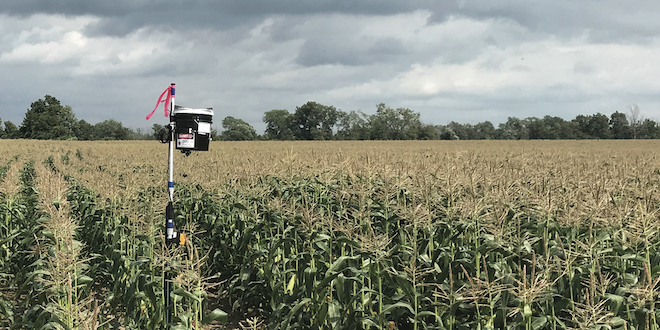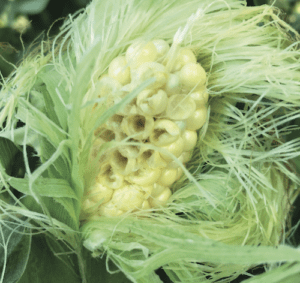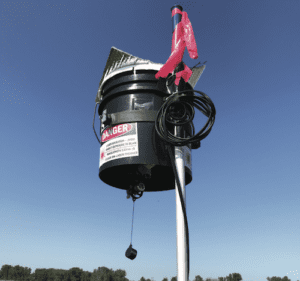
May 6, 2022Laser scarecrows studied to deter birds from fields
A high-tech solution employing the power of light can help growers protect their crops from birds. Laser beams are being tested to scare birds from sweet corn fields and other crops.
A laser scarecrow system being tested in the Northeast deploys a constantly moving green laser beam to frighten birds from the fields. In a March 22 webinar, researchers from the University of Rhode Island (URI) and Cornell Cooperative Extension shared research insights gained through examining use of the experimental laser scarecrow.
The open source 50-milliwatt scarecrows were tested on New York farms. The URI units cover up to nine acres and sell for $650. They are designed for growers with smaller fields or fields with multiple varying elevations, operations that likely won’t see economies of scale to justify larger units. The researchers want to offer the scarecrows to cooperating growers at close to researchers’ costs, said Rebecca Nelson Brown, associate professor in URI’s Department of Plant Sciences and Entomology.

The second season of testing the URI units on sweet corn, a major Rhode Island crop, began in April. The scarecrows are also used to scare birds from blueberries and grapes. Sweet cherries are also being considered. After a grower inquired if the scarecrows have been tested in cherry orchards, presenters said lasers have been used in British Columbia orchards. Researchers said they could likely find a cooperator for such tests.
Newly improved laser scarecrow kits are to be again available this year for those who partner with the researchers.
“It’s fairly new technology used in ag,” said Brown. “Lots of studies haven’t been done yet.”
Birds possess strong eyesight, about 10 times greater than humans’, but vary by species. Birds can quickly identify and ignore deterrents like scary-eyed balloons, effigies and startling noises, a reason propane canons possess limited effectiveness.
“Like when we tune-out a constant background noise, the birds will tune out,” said Brown. “The challenge is how do we propel birds from a large area without physically traversing the area?”
Improvements in laser and battery technology removed limitations of early 1970s non-automated, gas-powered technology. While modern research examines daytime application, previous research focused on low-light scenarios. Studies targeted disrupting roosting birds at sunset. The birds, however, would often return, said Brown.
Laser light prevents birds from perching on tops of corn tassels before moving lower to feed. Stopping perching on the tassels will make birds keeping watch for flock mates move and relocate the whole flock, said Brown.
“As far as efficacy, they work very well,” said David Brown, Rebecca Brown’s spouse who works in URI’s Department of Computer Science and Statistics. David Brown has worked with laser scarecrows since 2017. “They are another tool to add to our tool box,” he said. “But, like anything else, there’s this little caveat. You must get them out there early before those scouters are out looking. If we can keep them out, you can do a much better job keeping the rest of the flock out. Try to get them out there as silking starts or at the tail end of silking.”

A shortcoming of most bird scare technology is birds becoming familiar with the scare tactics. The laser research demonstrates birds do not appear to become acclimated to lasers and instead, become more afraid of them with repeated exposure, said Brown.
Research shows lasers in general work best on flocking birds. Blackbirds, cedar waxwings, cormorants, cowbirds, geese, gulls, robins and starlings appear most affected by the technology. Other studies are underway examining controlling different species with lasers.
Because crows haven’t been a big problem at the Rhode Island test field, researchers haven’t tested them. Grower webinar participants report experiencing little success discouraging crows. The URI units should work against crows, but depend on flock size and erecting lasers before crows discover the field, said Brown.
For any crop, growers should start laser protection before the birds begin feeding on the crop. For corn, that’s before maturity, ahead of scouts arriving to check out the fields.
Lasers should be mounted at corn tassel height with beams projected horizontally. On slopes, scarecrows should be mounted on top with beams aimed down the slope, hitting tassel tops. To protect blocks of varying height, the lasers should be erected on the side of the shorter plants, preventing taller plants from shading beams.
For blueberries, scarecrows should be mounted three feet above the canopy, moving the beam through the entire range of motion as well as horizontally to cover as many different parts of the canopy as possible. If grape clusters
are of differing heights, the vineyards should be treated like blueberries with a moving beam.
To avoid blinding pilots operating aircraft, care should be taken to not angle lasers at higher levels. The scarecrows can be mounted high and aimed down. A tape barrier system allows sensors to mark areas to skip shining on nearby homes or roadways, said David Brown.
The scarecrows require frequent monitoring.
“You cannot set it and forget about it,” said David Brown.
Growers should monitor them to ensure the units and their batteries are operating properly. Up to 90% of URI’s work involves use of other deterrents, including propane cannons. A laser may be positioned at one end of the field with a cannon at the other.
“That just keeps those birds on edge enough because they don’t know what’s coming next, light or scare,” said David Brown. “Though it’s hard to do when you have neighbors, if you can backup with a shotgun blast once in a while,
it reinforces the whole idea and keeps birds on their toes.”
Lasers haven’t worked well discouraging mammals, such as deer. Anecdotal evidence shows laser scarecrows sold by Avix Autonomic from Bird Control Group can be used to build a virtual fence against deer. However, studies have shown deer do not respond to lasers, said Rebecca Brown. In general, mammals detect threats through scent and sound.
Researchers seek growers interested in commercializing the researchers’ or similar laser systems. The Avix unit is the only commercial laser scarecrow specifically designed for agricultural use, said Brown, and Avix’s 500 milliwatt lasers can cover 20-100 acres for $10,000. The URI units were designed to ship inexpensively so growers can easily deploy in fields, particularly those with multiple plantings.
As grant funding is concluding, further development on the URI units remains uncertain. However, many potential areas of improvement have been suggested, including ease of use by adding external controls replacing the main circuit board’s interior location.
More information can be found at http://laserscarecrow.info.
— Doug Ohlemeier, assistant editor
















